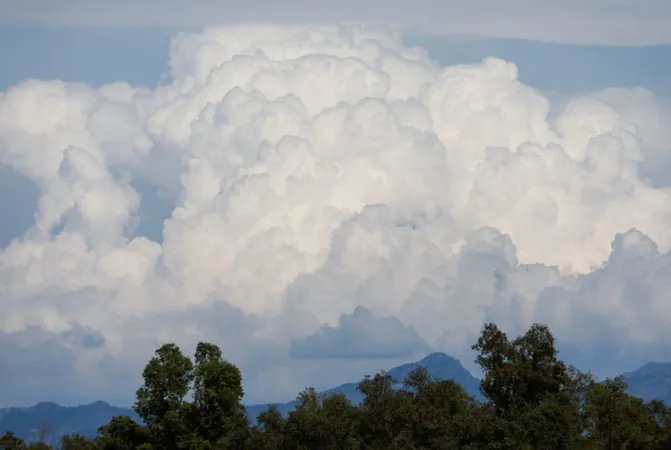
Microplastics May Be Changing Our Weather: Unraveling Their Impact on Clouds
2024-11-10
Author: Jacob
Introduction
In a groundbreaking discovery, researchers have unveiled that microplastics—tiny plastic fragments less than 5 millimeters in size—could be influencing weather patterns and climate by serving as nuclei for cloud formation in conditions where clouds would not typically develop.
Nucleation: The Key to Cloud Formation
As atmospheric chemists, we focus on a phenomenon known as nucleation, the process by which particles facilitate the formation of ice when they come into contact with liquid water. This process is essential to understanding how clouds interact with Earth's climate system.
The Role of Microplastics in Clouds
Clouds are composed of liquid water droplets, ice particles, or a combination of both. In specific atmospheric conditions, typically between 32°F to -36°F (0°C to -38°C), ice crystals normally coalesce around mineral dust or biological particles, such as pollen and bacteria. Microplastics, however, have been found in some of the most remote locations on Earth, from the depths of Antarctic oceans to the summit of Mount Everest and in pristine Antarctic snow. Their minuscule size allows them to be easily suspended and transported in the atmosphere.
Impact of Clouds on Weather and Climate
Clouds play a pivotal role in dictating weather patterns, including precipitation and temperature regulation. Ice formation in clouds is particularly crucial, as most precipitation initiates from ice particles. In many regions around the globe, clouds reach altitudes where temperatures are low enough that moisture begins to freeze. The process occurs when ice crystals gather moisture from surrounding liquid droplets, eventually becoming heavy enough to fall as precipitation.
Supercooling and Nucleating Agents
Interestingly, while we learn that water freezes at 32°F (0°C), this isn't universally true. Without nucleating agents, like dust particles, supercooling can occur, allowing water to remain liquid at temperatures as low as -36°F (-38°C). The presence of non-water-soluble materials—such as microplastics—can facilitate ice formation at these warmer temperatures, potentially increasing rainfall and snowfall.
Clouds and Earth's Energy Balance
Moreover, clouds significantly impact climate by regulating Earth's energy balance. They can cool the planet by reflecting sunlight while also absorbing radiation that warms the surface. The type of particles present in clouds, and their state (whether liquid or ice), can affect this dynamic. If microplastics tend to increase the formation of ice compared to liquid droplets, they might alter how clouds interact with sunlight, thereby impacting overall climate moderation.
Research Findings on Microplastics
In our research, we sought to determine whether microplastics can indeed act as nuclei for water droplets. We investigated four common types of plastics: low-density polyethylene, polypropylene, polyvinyl chloride, and polyethylene terephthalate, analyzing both their pristine state and post-exposure to environmental conditions, including UV light and acids.
Upon suspending the microplastics in water droplets and cooling them progressively, we found that around 50% of the droplets froze at -8°F (-22°C), suggesting that certain microplastics can nucleate ice at higher temperatures than non-plastic droplets. However, exposure to environmental factors like UV radiation and ozone did diminish their nucleation abilities, indicating that small chemical changes can influence microplastic properties.
Future Research Directions
One critical area requiring further exploration is the concentration of microplastics in the atmosphere at cloud-forming altitudes. We must also consider how these plastic particles stack up against other ice-nucleating agents like mineral dust and biological particles. Identifying these levels will enhance our ability to model the potential impact of microplastics on cloud dynamics.
As we continue our investigations, future studies will delve into various plastics, including those with additives such as plasticizers and colorants, as well as smaller particle sizes. This research could revolutionize our understanding of microplastics' broader implications on climate and weather patterns worldwide.
Conclusion
Stay tuned as we unravel the enigma of microplastics in our atmosphere and their potential role in shaping our planet's climate!









 Brasil (PT)
Brasil (PT)
 Canada (EN)
Canada (EN)
 Chile (ES)
Chile (ES)
 España (ES)
España (ES)
 France (FR)
France (FR)
 Hong Kong (EN)
Hong Kong (EN)
 Italia (IT)
Italia (IT)
 日本 (JA)
日本 (JA)
 Magyarország (HU)
Magyarország (HU)
 Norge (NO)
Norge (NO)
 Polska (PL)
Polska (PL)
 Schweiz (DE)
Schweiz (DE)
 Singapore (EN)
Singapore (EN)
 Sverige (SV)
Sverige (SV)
 Suomi (FI)
Suomi (FI)
 Türkiye (TR)
Türkiye (TR)